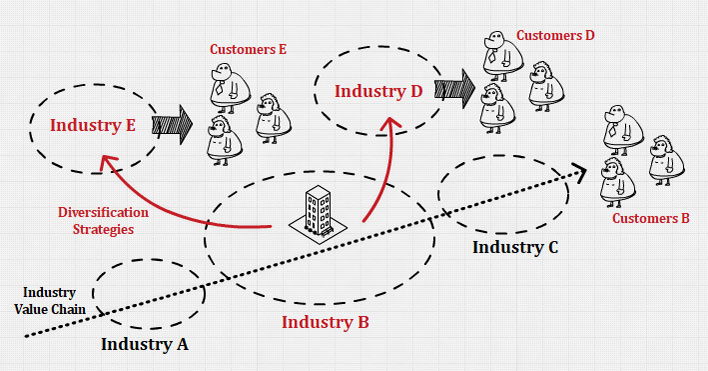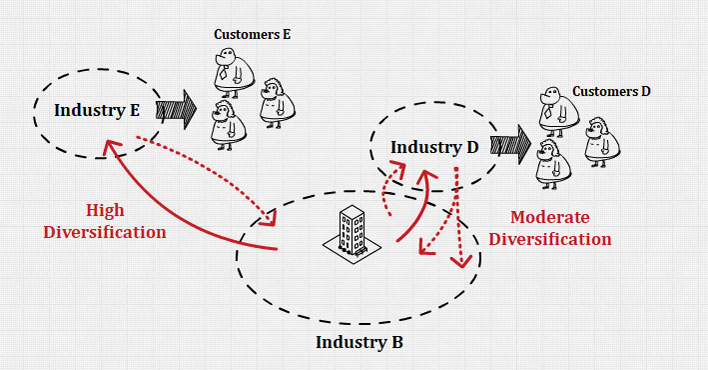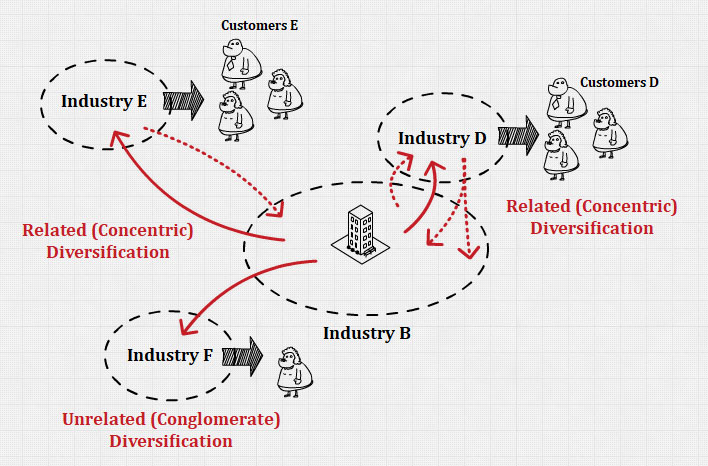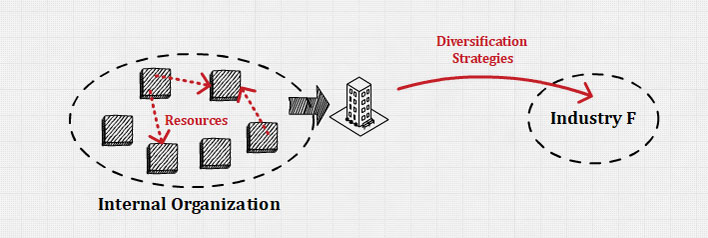The Nature of Diversification Strategies

What is a Diversification Strategy?
Diversification is the process of entering one or more industries that are distinct or different from a company’s core or original industry, in order to find ways to use its distinctive competencies to increase the value of products in those industries to customers.
Thus, a diversified company is one that operates in two or more different or distinct industries (industries not in adjacent stages of an industry value chain as in vertical integration) to find ways to increase its long-run profitability.
In each industry a company enters, it establishes an operating division or business unit, which is essentially a self-contained company that performs a complete set of the value chain functions needed to make and sell products for that particular market.
Once again, to increase profitability, a diversification strategy should enable the company, or its individual business units, to perform one or more of the value chain functions either at a lower cost or in a way that results in higher differentiation and premium prices.
Successful diversification is expected to reduce variability in the firm’s profitability as earnings are generated from different businesses. Diversification can also provide firms with the flexibility to shift their investments to markets where the greatest returns are possible rather than being dependent on only one or a few markets.
The greatest risk of being in a single industry and not diversifying is having all of the firm’s eggs in one basket. Although many firms are successfully operating in a single industry, new technologies, new products, or fast-shifting buyer preferences can decimate a particular business.
Diversification must do more than simply spread business risk across different industries because shareholders could accomplish this by simply purchasing equity in different firms across different industries or by investing in mutual funds.
Thus, diversification makes sense only to the extent the strategy adds more to shareholder value than what shareholders could accomplish acting individually. The chosen industry for diversification must be attractive enough to yield consistently high returns on investment and offer potential across the operating divisions for synergies greater than those entities could achieve alone.
Firms using diversification strategies enter entirely new industries, while firms using vertical integration stays in the same value chain of their industry.
While vertical integration involves a firm moving into a new part of a value chain that it is already is within, diversification requires moving into new value chains. Many firms accomplish this through a merger or an acquisition, while others expand into new industries without the involvement of another firm.
Reasons for Diversification
A firm uses a corporate-level diversification strategy for a variety of reasons.
First, a diversification strategy is used to increase the firm’s value by improving its overall performance. Value is created either through related diversification or through unrelated diversification when the strategy allows a company’s businesses to increase revenues or reduce costs while implementing their business-level strategies.
Companies may also start thinking about diversification when their opportunities for growth in the original business have been depleted. This often occurs in an industry that already consolidates and becomes mature, and most of the surviving firms have reached the limits of growth using vertical and horizontal growth strategies. Companies have to diversify into different industries if they want to continue growing and increase the firm’s value.
Second, a value-neutral reason for diversification is a desire to match and thereby neutralize a competitor’s market power.
Third, an expansion of the firm’s portfolio of businesses can reduce managerial risk and increase top managers’ pay. Greater amounts of diversification reduce managerial risk in that if one of the businesses in a diversified firm fails, the top executive of that business does not risk total failure by the corporation. As such, this reduces the top executive’s employment risk. In addition, because diversification can increase a firm’s size and thus managerial compensation, managers have motives to diversify a firm.
Are Firms Suitable for Diversification?
High-performing companies first choose corporate-level strategies that allow them to achieve the best competitive position in their core business or market. Then they may vertically integrate to strengthen their competitive advantage in that industry.
At this point, strategic managers must make another decision about how to invest their company’s growing resources and capital to maximize its long-run profitability. Thus, they must decide whether to pursue the corporate-level strategy of diversification.
A firm should pass the following 3 tests in order to determine whether it should participate in diversification.
They are as follows: (1) How attractive is the industry that a firm is considering entering? Unless the industry has strong profit potential, entering it may be very risky; (2) How much will it cost to enter the industry? Executives need to be sure that their firm can recoup the expenses that it absorbs in order to diversify; and (3) Will the new unit and the firm be better off? Unless one side or the other gains a competitive advantage, diversification should be avoided.
Levels of Diversification

Diversified firms vary according to their level of diversification and the connections between and among their businesses.
There are 5 categories of businesses according to 3 increasing levels of diversification.
Low Levels of Diversification
The single and dominant business categories denote no or relatively low levels of diversification. A firm pursuing a low level of diversification uses either a single- or a dominant-business corporate-level diversification strategy.
A single-business diversification strategy is a corporate-level strategy wherein the firm generates 95 percent or more of its sales revenue from its core business area.
Firms that focus on one or very few businesses and markets can earn positive returns because they develop capabilities useful for these markets and can provide superior service to their customers. Additionally, there are fewer challenges in managing one or a very small set of businesses, allowing them to gain economies of scale and efficiently use their resources.
Moderate Levels of Diversification
More fully diversified firms are classified into related categories. A firm is related through its diversification when its businesses share several links. The more links among businesses, the more constrained is the level of diversification.
Related diversification is the strategy of operating a business unit in a new industry that is related to a company’s existing business units by some form of linkage or connection between one or more components of each business unit’s value chain. Normally, these linkages are based on manufacturing, marketing, or technological connections or similarities.
A firm generating more than 30 percent of its revenue outside a dominant business and whose businesses are related to each other in some manner uses a related diversification corporate-level strategy.
When the links between the diversified firm’s businesses are rather direct, meaning they use similar sourcing, throughput, and outbound processes, it is a related constrained diversification strategy. A firm shares resources and activities across its businesses with a related constrained strategy.
High Levels of Diversification
Unrelated diversification refers to the absence of direct links between businesses.
Unrelated diversification is diversification into a new business or industry that has no obvious value chain connection with any of the businesses or industries in which a company is currently operating. A company pursuing unrelated diversification is often called a conglomerate, a term that implies the company is made up of a number of diverse businesses.
Types of Diversification Strategies

The 2 basic diversification strategies are concentric (related) and conglomerate (unrelated).
Type 1: Concentric (Related) Diversification
Concentric (related) diversification is growth into a related industry when a firm has a strong competitive position, but current industry attractiveness is low.
For companies in leadership positions, the chances for success are much higher than those of followers. The organization focuses on its distinctive competence as a means of diversification.
Related diversification occurs when a firm moves into a new industry that has important similarities with the firm’s existing industry or industries.
Some firms that engage in related diversification aim to develop and exploit a core competency to become more successful. A core competency is a skill set that is difficult for competitors to imitate, can be leveraged in different businesses, and contributes to the benefits enjoyed by customers within each business.
Most companies favor concentric (related) diversification strategies in order to capitalize on synergies as follows: (1) Transferring competitively valuable expertise, technological know-how, or other capabilities from one business to another; (2) Combining the related activities of separate businesses into a single operation to achieve lower costs; (3) Exploiting common use of a well-known brand name; and (4) Cross-business collaboration to create competitively valuable resource strengths and capabilities.
There are six guidelines for when related diversification may be an effective strategy.
They are as follows: (1) When an organization competes in a no-growth or a slow-growth industry; (2) When adding new, but related, products would significantly enhance the sales of current products; (3) When new, but related, products could be offered at highly competitive prices; (4) When new, but related, products have seasonal sales levels that counterbalance an organization’s existing peaks and valleys; (5) When an organization’s products are currently in the declining stage of the product’s life cycle; and (6) When an organization has a strong management team.
Type 2: Conglomerate (Unrelated) Diversification
Conglomerate (unrelated) diversification is growth into industries unrelated to the current ones. This strategy is viable especially when management realizes that the current industry is unattractive, but the firm lacks outstanding abilities or skills that it could transfer to related products or services in other industries.
A conglomerate diversification strategy favors capitalizing on a portfolio of businesses that can deliver excellent financial performance in their respective industries, rather than striving to capitalize on value chain strategic fits among the businesses.
Thus, the emphasis in conglomerate diversification is on sound investment and management rather than on product-market synergy. Rather than maintaining a common thread throughout the organization, management concerns more with financial considerations of cash flow and risk reduction.
Firms that employ unrelated diversification continually search across different industries for companies that can be acquired for a deal and yet have the potential to provide a high return on investment. Pursuing unrelated diversification entails being on the hunt to acquire companies whose assets are undervalued, or companies that are financially distressed, or companies that have high growth prospects but are short on investment capital.
An obvious drawback of conglomerate diversification is that it is much more difficult to manage businesses in many industries than in a single industry. The parent firm must have an excellent top management team that plans, organizes, motivates, delegates, and controls effectively.
There are ten guidelines for when conglomerate diversification may be an especially effective strategy.
They are as follows: (1) When revenues derived from an organization’s current products or services would increase significantly by adding the new, unrelated products; (2) When an organization competes in a highly competitive and/or a no-growth industry, as indicated by low industry profit margins and returns; (3) When an organization’s present channels of distribution can be used to market the new products to current customers; (4) When the new products have countercyclical sales patterns compared to an organization’s present products; (5) When an organization’s basic industry is experiencing declining annual sales and profits; (6) When an organization has the capital and managerial talent needed to compete successfully in a new industry; (7) When an organization has the opportunity to purchase an unrelated business that is an attractive investment opportunity; (8) When there exists financial synergy between the acquired and acquiring firm; (9) When existing markets for an organization’s present products are saturated; and (10) When antitrust action could be charged against an organization that historically has concentrated on a single industry.
Related Diversification versus Unrelated Diversification
One issue that a diversifying company must resolve is whether to diversify into totally new businesses and industries or into those that are related to its existing business because their value chains share something in common.
The choices it makes determine whether a company pursues related diversification and/or unrelated diversification.
By definition, a related company can create value by resource sharing and by transferring competencies between businesses. It can also carry out some restructuring. In contrast, because there are no connections or similarities between the value chains of unrelated businesses, an unrelated company cannot create value by sharing resources or transferring competencies. Unrelated diversifiers can create value only by pursuing an acquisition and restructuring strategy.
Resources and Diversification

A firm must have the types and levels of resources and capabilities needed to successfully use a corporate-level diversification strategy.
Although both tangible and intangible resources facilitate diversification, they vary in their ability to create value. Indeed, the degree to which resources are valuable, rare, difficult to imitate, and nonsubstitutable influences a firm’s ability to create value through diversification.
For instance, free cash flows are a tangible financial resource that may be used to diversify the firm. However, compared with diversification that is grounded in intangible resources, diversification based on financial resources only is more visible to competitors and thus more imitable and less likely to create value on a long-term basis.
Tangible resources may create resource interrelationships in production, marketing, procurement, and technology, defined earlier as activity sharing. Tangible resources usually include the plant and equipment necessary to produce a product and tend to be less flexible assets. Any excess capacity often can be used only for closely related products, especially those requiring highly similar manufacturing technologies.
The excess capacity of other tangible resources, such as a sales force, can be used to diversify more easily. Again, excess capacity in a sales force is more effective with related diversification because it may be utilized to sell products in similar markets. The salesforce would be more knowledgeable about related product characteristics, customers, and distribution channels.
Intangible resources are more flexible than tangible physical assets in facilitating diversification. Although the sharing of tangible resources may induce diversification, intangible resources such as tacit knowledge could encourage even more diversification.
Sometimes, however, the benefits expected from using resources to diversify the firm for either value-creating or value-neutral reasons are not gained.
Resources
Further Reading
- What is Product Diversification? (corporatefinanceinstitute.com)
- What is Diversification Strategy? (Definition and Examples) (lightercapital.com)
- Diversification Business Strategy – Explained (thebusinessprofessor.com)
- The Four Types of Diversification Strategies (spring-green.com)
- Diversification Strategy – Definition, Types & Examples (marketingtutor.net)
- Real Types of Diversification Strategies – An Analysis of different Types of Relatedness in German Companies (grin.com)
- What Is Diversification Strategy? (plus Examples) (fundsquire.co.uk)
- Diversification Strategy (welpmagazine.com)
- Diversification Strategy Guide (getlucidity.com)
Related Concepts
- Corporate Directional Strategies
- Value in Diversification Strategies
- Creating Value with Diversification
References
- Hitt, M. A., Ireland, D. R., & Hoskisson, R. E. (2019). Strategic Management: Concepts and Cases: Competitiveness and Globalization (MindTap Course List) (13th ed.). Cengage Learning.
- Hill, C. W. L., & Jones, G. R. (2011). Essentials of Strategic Management (Available Titles CourseMate) (3rd ed.). Cengage Learning.
- Mastering Strategic Management. (2016, January 18). Open Textbooks for Hong Kong.
- Wheelen, T. L. (2021). Strategic Management and Business Policy: Toward Global Sustainability 13th (thirteenth) edition Text Only. Prentice Hall.